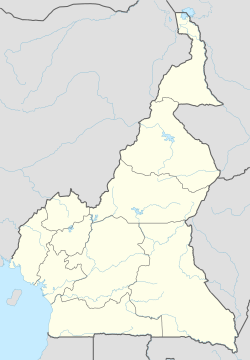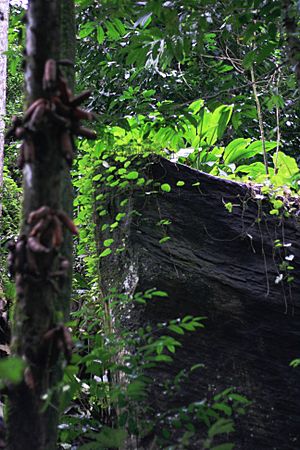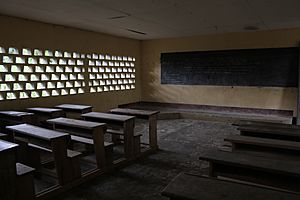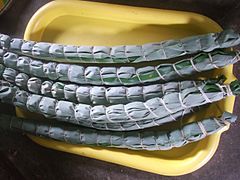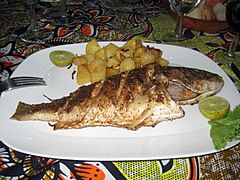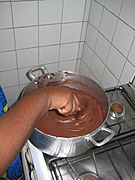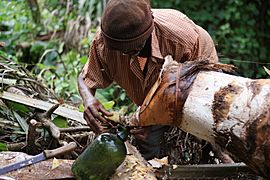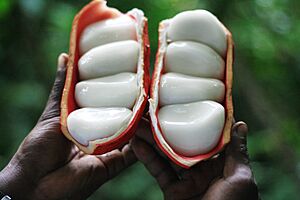Tayap facts for kids
Quick facts for kids
Tayap
|
|
|---|---|
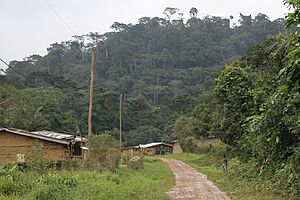
Tayap
|
|
| Country | Cameroon |
| Region | Centre Region |
| Department | Nyong-et-Kéllé |
| Elevation | 350 m (1,150 ft) |
| Population
(2010)
|
|
| • Total | 254 (census) |
Tayap is a small village in Cameroon, a country in Africa. It's located in the Centre Region, between two big cities: Yaounde (the capital) and Douala. Tayap is part of the Ngog-Mapubi district.
Tayap is found in the Congo Basin forest, which is the world's second-largest rain forest. Sadly, the village has been affected by deforestation in Cameroon. This happens because more people live there, logging (cutting down trees) has grown, people collect wood for fires, and they use a farming method called slash-and-burn.
Since 2011, Tayap has been working on a special project. This project uses agroecology (eco-friendly farming) and ecotourism (tourism that helps nature). The goal is to protect the village's amazing plants and animals, save its land, and help people earn money.
Contents
Geography of Tayap
Where is Tayap Located?
Tayap is located at 3°49’2.067’’N and 10°54'5.106’’E. It shares borders with other villages. To the north are Omog and Mamb. To the west are Mamb Kelle and Song Mpeck. Lamal Pougue is to the east, and Nlep be and Ngong are to the south.
The village is about 86 kilometers (53 miles) from Yaounde. It's also 12 kilometers (7.5 miles) from Boumnyebel, which is on the main road between Douala and Yaounde. Tayap is connected to this main road by a dirt path. This path is not always kept in good shape, so traveling can be hard when it rains.
Tayap's Climate
Tayap has a humid, equatorial climate. This means it has four seasons: two dry seasons and two wet seasons. The main wet season is from August to October, and a shorter wet season is from March to May. The main dry season is from November to February, with a shorter one in June and July.
The average temperature in Tayap is 25°C (77°F). The amount of rain each year is between 1,500 and 2,500 millimeters (59 to 98 inches).
Rocks and Caves in Tayap
Tayap is about 350 meters (1,150 feet) above sea level. It has many hills with steep sides. The ground here is rich in rocks like quartzite (a type of silicate rock) and magnetic rocks such as pyrites and micaschist.
Tayap also has many interesting caves and rock formations. On its highest hill, which is over 544 meters (1,785 feet) tall, you can find caves. One of these caves is home to nests of the bald rockfowl. This is a special bird that is in danger of disappearing. One triangular-shaped rock forms a natural shelter over 100 meters (328 feet) high. This spot was used as a hiding place by Cameroonian freedom fighters during their struggle for independence.
Tayap's Environment
Tayap is in the northern part of the Congo Basin forest. Most of the plants here are woodlands. There are two main types of forests:
- Primary forest: This is the original, untouched forest found on the hilltops.
- Secondary forest: This forest grows back after the primary forest has been cut down for farming or logging.
The Congo Basin forest is facing damage from deforestation in certain areas. This is because logging has grown a lot. Cameroon started logging more to make up for lower prices of cocoa and coffee in the 1990s. Also, people practice "cultivation on burned ground" (slash-and-burn farming) in these tropical forest areas. Each year, about 80,000 to 200,000 hectares (197,000 to 494,000 acres) of forest are lost in Cameroon. Tayap still has about 1,400 hectares (3,460 acres) of forest, mostly on the hilltops. This is about 30% of its total area.
History of Tayap
After World War II, Cameroon was looked after by France and Britain. In the 1940s and 1950s, a group called the Union of the Peoples of Cameroon (UPC) played a big part in Cameroon's journey to independence. This group was led by Ruben Um Nyobe.
In 1955, the UPC was banned, and its leaders started to resist from the bush. The area around Tayap became a strong base for these freedom fighters, especially among the Bassa group. Historians say that after 1956, about fifteen people from the nearby village of Ngog joined the resistance in the bush.
People and Life in Tayap
Tayap's Population
In 2010, the last time a count was done, Tayap had 254 people living in 57 households. There were 132 men (52%) and 122 women (48%). Most of the people are young and belong to the Bassa group. A smaller number (8%) are from other Cameroonian tribes like the Bamenda, Bamileke, Hausa, and Beti.
The village is spread out along roads and paths, with many small groups of houses called hamlets. These hamlets are usually 0.5 to 2 kilometers (0.3 to 1.2 miles) apart. The two main areas are central Tayap and Libolo. The village has about sixty houses in total.
Basic Services in Tayap
Tayap gets its drinking water from three wells. People use hand pumps to get the water, then carry it in buckets or containers.
Even though there's a power line in the nearby village of Omog, Tayap does not have electricity. This lack of electricity makes it hard for the village to grow and develop. There are no strong winds for wind power, and no rivers close enough for hydroelectric power.
Education in Tayap
In 2003, the people of Tayap built a primary school. In its first year, 34 children aged six and older attended. By 2010, the school had 75 students. The school is about 1.5 kilometers (1 mile) from both Libolo and central Tayap.
In April 2006, the Cameroonian government added two more classrooms. This brought the total number of public school classrooms in Tayap to four. Each classroom teaches two different grade levels. This way, the school can offer all six levels of primary education. After primary school, students go to secondary schools in Lamal-Pougoue or Mamb.
Religion in Tayap
Most people in Tayap are Christian, either Catholic or Protestant. There are two places of worship in the village: a Cameroon Presbyterian church and a Catholic church.
Culture in Tayap
The people of Tayap keep their culture alive through several traditions:
- Food: A famous dish is bongo’o tchobi, which is fish served with macabo, plantain, cassava, or cassava sticks. For breakfast, they enjoy mintoumba, a cassava cake, often with traditional palm wine.
- Music and Dance: They enjoy Ngola chants and the Assiko belly dance.
- Marriage Traditions: Cultural marriage has three steps:
- li bat Ngond: This means "the proposal of marriage" in the basaa language.
- li ti pos: This means "give the bottle" for the engagement.
- bijeck bi lon: This means "food for the family" for the traditional marriage ceremony.
- Traditional Medicine: They use plants from the countryside to make traditional medicines.
Tayap's Economy
In 2013, 179 people in Tayap were working. Most jobs in the village are related to farming.
Farming in Tayap
Farming is the main way people in Tayap earn money. They also trade in non-timber forest products (products from the forest that are not wood).
Farming activities include:
- Cash crops: Like cocoa and palm oil, which are grown to sell.
- Food crops: Such as plantains, cassava, cocoyam, taro, peanuts, and bananas.
- Fruits: Including bush pear, mango, lemon, orange, grapefruit, papaya, and kola nuts.
- Market gardening: Growing vegetables like pimento.
These products are sold in Boumnyebel and Yaounde.
Other Ways People Earn Money
People in Tayap also raise small animals, fish, and hunt. The village has six places where palm oil is pressed. There are also local groups that help people with small loans.
Tayap is developing ecotourism. Two eco-lodges have been built, and existing guest houses are being recognized. This offers tourists a place to stay and provides extra income for the villagers. Some people also earn money by illegally cutting down trees in the forest.
Local Development Projects
Since 2011, Tayap has been part of a special project called "The Ecological Orchards of Tayap." This project focuses on agro-ecology and ecotourism. It aims to fight deforestation, protect the village's natural environment, and create ways for people to earn money.
In 2011, this project won the SEED prize. This award comes from a global partnership that supports businesses helping the environment and development.
Between 2014 and 2015, the project helped restore 110 hectares (272 acres) of forest. It also set up three "green classes" for local children and created some eco-friendly jobs for young people. Two eco-houses were built to welcome tourists, helping to grow ecotourism as another way for locals to earn money.
A special fund of 1,000,000 francs was also created. This fund gives small loans to women and helps new business ideas. The project also created a series of comic strips. These comics tell the story of Tayap's development and the challenges African villages face with deforestation and slash-and-burn farming.
In 2015, the project won another award, the "Agriculture and Forests Climate Challenge" prize, for helping to reduce climate change in farming. In 2016, Yale University gave the project its ISTF Innovation Prize.
Transport in Tayap
Tayap is about an hour's drive from Yaounde and two hours from Douala, using the main motorway that connects them. The railway line between Douala and Yaounde does not go through Tayap.
See also
 In Spanish: Tayap para niños
In Spanish: Tayap para niños


